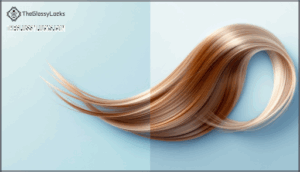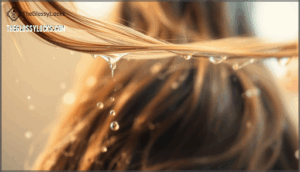This site is supported by our readers. We may earn a commission, at no cost to you, if you purchase through links.

This property isn’t just about avoiding breakage; it reveals the internal structure of your hair shaft, particularly the balance between moisture and protein that keeps strands resilient. When elasticity is ideal, your hair can stretch up to 50% of its length when wet and bounce back without damage. When it’s compromised, even gentle styling becomes a breaking point.
Understanding what elasticity means for your hair—and learning to read the signs your strands are sending—gives you the foundation to reverse damage and maintain genuinely healthy hair.
Table Of Contents
- Key Takeaways
- Hair Elasticity Meaning and Definition
- The Science Behind Hair Elasticity
- Factors Affecting Hair Elasticity
- Signs of Healthy Vs. Poor Elasticity
- How to Test Hair Elasticity at Home
- Improving and Maintaining Hair Elasticity
- Preventing and Repairing Elasticity Damage
- Frequently Asked Questions (FAQs)
- What are the signs of low elasticity in hair?
- What can I do to improve my hair’s elasticity?
- Is there a way to test for elasticity without damaging my hair?
- How often should I check my hair’s elasticity?
- Does hair elasticity change with age?
- Can hair elasticity improve with dietary changes alone?
- Does hair elasticity differ between men and women?
- How long does it take to restore elasticity?
- Can over-conditioning reduce hair elasticity over time?
- Is hair elasticity genetic or lifestyle-dependent?
- Conclusion
Key Takeaways
- Hair elasticity measures your strands’ ability to stretch up to 50% when wet and bounce back without breaking, functioning as a direct indicator of the moisture-protein balance that determines whether your hair withstands daily styling or snaps under pressure.
- You can test elasticity at home with a simple wet stretch test—healthy hair stretches roughly 30% and returns to its original length, while damaged hair either snaps immediately or stays stretched out, revealing exactly where your hair stands.
- Compromised elasticity shows up as brittleness, dullness, constant tangling, and breakage during routine styling, caused by heat damage, chemical treatments, environmental stressors, or moisture-protein imbalances that weaken the internal bonds holding your hair structure together.
- Restoring elasticity requires a strategic approach combining weekly deep conditioning for moisture restoration, balanced protein treatments every 4-6 weeks to strengthen the hair shaft, and protective practices like minimizing heat styling and using silk pillowcases to prevent ongoing damage.
Hair Elasticity Meaning and Definition
Hair elasticity is one of those terms you’ll hear at salons, but what does it actually mean for your hair? Understanding elasticity helps you figure out whether your hair is truly healthy or just looks the part.
Let’s break down what elasticity is, how it’s measured, and why it should matter to you.
What is Hair Elasticity?
Think of hair elasticity as your hair’s ability to act like a rubber band—it’s how far each strand can stretch before snapping back (or breaking altogether). When your hairs stretch and bounce back without damage, that’s healthy hair elasticity at work.
This elasticity defined means your hair structure has the right balance of moisture and strength to endure daily styling and manipulation. Without it, you’ll face constant hair breakage and poor hair manageability—your strands simply can’t withstand the stress.
How Hair Elasticity is Measured
You can measure hair elasticity right at home with a simple stretch test—no lab coat required. Take a single wet strand, gently pull it, and watch how it responds. Here’s what to look for:
- Stretches 30–50% without breaking? High elasticity—you’re winning.
- Snaps immediately? Low elasticity—damage alert.
- Returns to original length? Excellent moisture and protein balance.
- Stays stretched out? Your hair needs serious hydration help.
For deeper insights, a salon elasticity assessment uses professional hair analysis tools and specialized elasticity measurement tools to interpret test results beyond what you’ll see at home.
Why Hair Elasticity Matters
Hair elasticity isn’t just a buzzword—it’s the difference between hair that bounces back from styling and hair that snaps off in your hands. When your hair has strong elasticity, you’re getting better manageability, reduced breakage, and that shine everyone notices.
It’s your frontline defense against hair damage—think of it as your hair’s resilience reserve. Without it, every brush stroke becomes a risk, and overall health takes a nosedive fast.
The Science Behind Hair Elasticity
Understanding what makes hair elastic starts with knowing what’s happening beneath the surface. Your hair’s structure, moisture levels, and internal bonds all work together to determine how well it stretches and bounces back.
Let’s break down the science so you can see exactly what affects your hair’s flexibility.
Structure of The Hair Shaft
Understanding your hair’s structure is like peeling back the layers of a perfectly engineered cable—each component plays an essential role in how well your strands perform under stress. The hair shaft consists of three distinct layers: the protective cuticle layers on the outside, the cortex composition in the middle containing hair bonds that determine shaft strength, and sometimes a medulla presence at the core.
Your hair’s diameter and overall hair structure directly influence how much stretch your strands can withstand before breaking.
Role of Moisture and Protein
Regarding hair elasticity, moisture and protein balance act like two sides of the same coin—you need both working together. Fully hydrated hair can absorb up to 30% of its weight in water, giving your strands that essential stretch and bounce.
But moisture absorption alone won’t cut it. Protein deficiency weakens your hair shaft, making it vulnerable to breakage even when hydrated. Balanced treatments that address both hydration effects and protein treatments reduce breakage by up to 50%, giving you resilient, flexible hair that withstands daily styling and environmental moisture changes.
Consistent use of hydrolyzed protein treatments can reinforce hair and are ideal for regular maintenance.
Hair Bonds and Elasticity
Think of your hair’s internal structure as a ladder—disulfide bonds form the sturdy side rails, hydrogen bonds act as flexible rungs, and salt bonds help stabilize the entire framework.
When you stretch your hair, hydrogen bonds temporarily break and reform, giving you that elastic snap-back. Disulfide bonds provide permanent strength along peptide chains, but chemical treatments or heat can damage this bond structure, leading to hair breakage.
Bond repair treatments work by rebuilding these connections, restoring both hair strength and hair elasticity simultaneously.
Factors Affecting Hair Elasticity
Your hair’s elasticity isn’t set in stone—it shifts based on what you expose it to and how you care for it. Everything from your natural curl pattern to the tools you use plays a role in whether your strands stay flexible or turn brittle.
Let’s break down the key factors that can make or break your hair’s bounce.
Hair Type and Texture
Your natural curl pattern doesn’t just determine your hairstyle—it actually shapes how elastic your strands can be. Curly and coily hair types often show higher natural elasticity due to their spring-like structure, but they’re also more vulnerable to breakage when dry.
Hair porosity and density play significant roles too—high-porosity hair loses moisture quickly, weakening elasticity across all texture variations and ethnic differences.
Environmental Influences
Sun, wind, humidity, and even the chlorine in your pool aren’t just weathering your mood—they’re quietly stripping your hair’s elastic resilience strand by strand.
Here’s how environmental stressors chip away at hair elasticity and trigger breakage:
- UV exposure degrades the protein structure in your hair shaft, weakening bonds that give hair its stretch-and-bounce ability
- Air pollution deposits particulates that create oxidative stress, leading to moisture loss and reduced hair hydration
- Water quality issues—like hard water minerals and chlorine—coat strands, disrupting the cuticle and compromising elasticity over time
Seasonal changes intensify these effects, with winter dryness and summer humidity swings directly impacting your hair’s ability to retain moisture and withstand daily styling.
Impact of Chemical Treatments
Chemical treatments—like bleaching, relaxers, and dyes—deliver some of the sharpest blows to hair elasticity. Relaxers cause protein loss up to 356% higher in treated hair, while repeated bleaching oxidizes the cortical keratin your elasticity depends on. These treatments weaken hair bonds, especially cystine, triggering structural damage and elasticity reduction.
Treatment frequency matters: 38% of users apply relaxers up to four times, and cumulative chemical exposure drastically increases hair breakage and brittleness due to compromised resilience. Chemical straightening can lead to improved hair smoothness.
Effects of Heat Styling
Heat styling tools—flat irons, curling wands, blow dryers—can raise hair temperatures to over 400°F, literally cooking the moisture out of your strands and leaving elasticity in ruins. Here’s what happens:
- Temperature matters: Repeated exposure above 350°F causes irreversible heat damage signs like brittleness and hair breakage.
- Styling frequency compounds damage: Daily heat styling accelerates protein degradation, weakening your hair’s natural stretch.
- Protective products create barriers: Heat protection sprays shield strands, helping prevent moisture loss and maintain hair elasticity.
Repairing heat-damage requires consistent moisture restoration and reduced thermal stress.
Signs of Healthy Vs. Poor Elasticity
Your hair tells you a lot about its elasticity if you know what to look for. Healthy, elastic hair behaves differently than damaged strands—and the differences show up in how your hair feels, moves, and reacts to styling.
Let’s break down the key signs that reveal whether your hair elasticity is thriving or struggling.
Characteristics of High Elasticity
When your hair can stretch like a rubber band and bounce right back without snapping, you’re looking at elasticity in its prime. This resilience translates to real benefits: smooth texture, natural shine, and styling adaptability that makes your daily routine easier.
Healthy hair structure depends on balanced moisture and protein, which together create the hair strength you can actually feel when you run your fingers through your strands.
| Characteristic | What You’ll Notice |
|---|---|
| Breakage Resistance | Hair withstands brushing, detangling, and manipulation without snapping |
| Bounce and Shine | Strands reflect light evenly and move with natural spring |
| Smooth Texture | Cuticles lie flat, creating a silky feel from root to tip |
| Styling Adaptability | Hair holds curls, braids, and styles without excessive damage |
| Manageability | Detangling is easier with less friction and fewer knots |
Signs of Low Elasticity
On the flip side, low elasticity shows up as brittleness—hair that snaps under tension instead of stretching, loses its shine, and feels dry or straw-like to the touch. You’ll notice excessive breakage during routine styling, limp curls that won’t maintain their shape, and strands that tangle easily. These signs point directly to compromised hair structure that needs immediate attention.
| Sign | What It Means | Impact |
|---|---|---|
| Brittle Strands | Hair snaps instead of stretches | Frequent breakage during brushing |
| Dull Appearance | Cuticle damage blocks light reflection | Loss of natural shine and vibrancy |
| Tangle Prone | Rough cuticles catch on each other | Painful detangling, more damage |
Common Symptoms of Elasticity Loss
Spotting these symptoms early allows you to intervene before damage becomes permanent. Brittle strands that snap during brushing signal weakened keratin bonds—studies show chemically treated hair breaks up to 55% more often than untreated hair. Styling breakage also increases dramatically; heat-damaged hair fractures 50% more during manipulation.
You’ll notice shape retention problems: your curls fall flat, and styled hair won’t maintain its form because moisture-depleted fibers can’t bounce back. Loss of shine occurs when damaged cuticles scatter light instead of reflecting it smoothly, creating a dull, lifeless look.
Finally, tangling issues multiply as rough cuticles catch on each other, making detangling painful and causing further hair damage through increased friction.
| Symptom | What You’ll Notice |
|---|---|
| Brittle Strands & Styling Breakage | Hair snaps when brushing; visible split ends multiply |
| Shape Retention & Loss Shine | Curls won’t maintain; surface looks dull and matte |
| Tangling Issues | Constant knots; painful combing sessions |
How to Test Hair Elasticity at Home
Testing your hair’s elasticity doesn’t require a lab coat or fancy equipment. A simple at-home stretch test can reveal whether your hair is thriving or crying out for help.
Here’s how to check your strands and what your results actually mean.
The Wet Stretch Test
The wet stretch test is your most reliable at-home method for gauging your hair’s true elasticity—and it takes less than a minute to perform. Start with a single clean strand, dampen it with lukewarm water (water temperature affects strand preparation), then gently pull both ends. Healthy hair stretches roughly 30% before returning to its original length—that’s your breakage point standard.
What you’ll notice during your hair elasticity test:
- Hair with strong elasticity bounces back like a spring, proving your hair strength is solid
- Weak strands snap immediately, signaling critical hair breakage risks that need attention
- The stretch test reveals exactly where your hair stands, giving you test accuracy for smarter care decisions
Interpreting Your Results
So what exactly does your stretch test reveal about your hair’s condition, and how do you translate those results into actionable next steps? If your strand stretched roughly 30% and bounced back, you’ve got solid hair elasticity—keep doing what you’re doing.
But if it snapped immediately or stretched beyond that breakage threshold without returning, you’re looking at damage that needs moisture or protein rebalancing.
Understanding breakage patterns through hair elasticity testing gives you elasticity test accuracy for setting realistic expectations about your elasticity improvement timeline.
When to Seek Professional Assessment
If you’ve been testing at home and still can’t pinpoint what’s throwing your hair off balance, it might be time to bring in a trichologist or professional stylist who can dig deeper into what’s really happening.
Severe breakage signs, scalp condition concerns, unexplained texture changes, or persistent elasticity loss that won’t improve with at-home moisture or protein treatments are all red flags that professional hair care assessment is needed to create a targeted treatment plan.
Improving and Maintaining Hair Elasticity
Once you’ve identified where your hair stands, it’s time to take action. Restoring and maintaining elasticity requires a strategic approach that balances moisture, protein, and protection.
Here’s how you can strengthen your strands and keep them flexible for the long haul.
Moisture Restoration Techniques
Restoring moisture to your hair isn’t just about slapping on conditioner—it’s about rebuilding the foundation that gives your strands their bounce and resilience. Focus on these hydration strategies:
- Deep conditioning treatments weekly to penetrate the hair shaft and restore elasticity
- Humectant-rich products with glycerin to attract moisture from the air
- Oil treatments using coconut or argan oil to seal the cuticle
- Hydration masks left on for 20-30 minutes for intensive moisture restoration
- Scalp health maintenance since healthy roots mean better hair hydration overall
Protein Treatments and Balance
Think of protein as the scaffolding that holds your hair structure together. Too much protein turns flexibility into brittleness.
Protein treatments repair weak spots in the cuticle and can nearly double mechanical strength in damaged hair. You’ll need them if your strands feel overly stretchy, limp, or gummy when wet.
Balance is everything: protein overload creates straw-like texture, while proper protein-moisture regimens restore elasticity and strengthen hair bonds without compromising softness.
Protective Hair Care Practices
Your daily habits—how you tie, sleep, and style—either protect elasticity or chip away at it with every touch. Gentle detangling starts from the ends, reducing hair breakage. Night protection with silk pillowcases minimizes friction. Low manipulation and protective styling prevent unnecessary stress on strands.
Scalp health directly influences hair care outcomes. Trim regularly to remove damaged ends that compromise hair protection and overall hair elasticity.
Recommended Products for Elasticity
Not all hair products are created equal—some feed your strands what they need, while others just coat the surface and call it a day. Look for products that deliver deep hydration and balanced protein:
- Hydrating shampoos and leave-in treatments replenish moisture without weighing hair down
- Protein conditioners and molecular hair repair products strengthen the hair shaft from within
- Natural oils and DIY masks seal the cuticle, restoring hair elasticity gradually
Choose hair care products based on your specific elasticity needs, not marketing hype.
Preventing and Repairing Elasticity Damage
Protecting your hair’s elasticity starts with knowing what damages it and how to avoid those pitfalls.
Once damage occurs, you’ll need targeted strategies to restore strength and flexibility. Here’s what you need to focus on to keep your hair resilient or bring it back from the brink.
Avoiding Common Causes of Damage
Protecting your hair from damage isn’t complicated—it starts with recognizing the everyday habits and exposures that quietly chip away at elasticity. Here’s what to avoid:
| Damage Cause | Why It Harms Hair Elasticity |
|---|---|
| Heat styling | Strips moisture from the cortex, weakening stretch capacity |
| Chemical overuse | Breaks down protein bonds, leading to brittleness |
| Sun exposure | Degrades cuticle layers and depletes natural moisture |
| Product buildup | Blocks hydration, creating stiff, inflexible strands |
Limit heat styling to twice weekly, space chemical treatments at least eight weeks apart, wear protective styles in harsh sun, and clarify monthly to prevent buildup.
Tips for Long-Term Hair Health
Long-term hair health isn’t about quick fixes—it’s about building habits that work. Adopt a consistent hair care routine to reduce breakage by 27% over a year, and pair it with weekly deep conditioning to boost hair elasticity by 19%.
Don’t skip scalp massage four times weekly; it improves thickness by 14%. Balance protein treatments every four to six weeks to strengthen strands without tipping into brittleness.
Protect hair moisture with silk pillowcases to cut breakage by 23% overnight.
When to Consult a Hair Specialist
Even with consistent care, sometimes your hair’s crying out for expert help beyond what you can do at home. When you notice persistent hair loss, stubborn breakage signs that won’t improve, or elasticity tests consistently showing poor results, it’s time for a specialist referral. A hair specialist can diagnose underlying damage repair needs and create targeted treatment plans.
Consult a professional when you experience:
- Progressive hair loss exceeding 150 strands daily despite improved hair care practices
- Persistent hair breakage at multiple points along the shaft rather than just the ends
- Elasticity that doesn’t improve after eight weeks of moisture and protein treatments
- Visible scalp changes, thinning patches, or sudden texture alterations affecting hair health
- Chemical or heat-induced hair damage that continues worsening despite stopping treatments
Frequently Asked Questions (FAQs)
What are the signs of low elasticity in hair?
When elasticity loss takes grip, your strands reveal the damage quickly. Hair breakage becomes frequent, brittle ends snap easily, and dryness signs appear through constant frizz factors and rough texture—clear indicators your hair can’t stretch and return.
What can I do to improve my hair’s elasticity?
Improving hair elasticity requires restoring hair moisture through deep conditioning treatments and hair masks, balancing protein with targeted elasticity products, and protecting strands from heat damage with hair oils.
Consistent hydration tips and gentle styling prevent hair breakage while supporting hair elasticity restoration.
Is there a way to test for elasticity without damaging my hair?
Like checking a rubber band’s bounce without overstretching it, gentle testing preserves your strands. The wet stretch test is a damage-free, non-invasive method: grasp a single hair, stretch it slightly, and observe.
Signs of healthy hair elasticity include spring-back without breakage—simple elasticity checks that protect your hair.
How often should I check my hair’s elasticity?
Check every 4-6 weeks as part of your regular hair monitoring routine, or more frequently if you’re undergoing chemical treatments, heat styling, or experiencing breakage.
Regular elasticity checks help track moisture levels and support damage control before visible problems develop.
Does hair elasticity change with age?
Absolutely, aging hair experiences a dramatic elasticity decline. As you age, your hair structure naturally weakens due to reduced moisture retention and protein degradation, making age-related elastic change inevitable.
This aging hair process increases hair breakage risk, directly impacting overall hair health over time.
Can hair elasticity improve with dietary changes alone?
Diet alone won’t fully restore hair elasticity, but addressing nutrient deficiency through a balanced diet rich in omega-rich foods, protein balance, and hair vitamins aids hair health.
Dietary supplements and food therapy complement topical treatments for maximum hair nutrition and hair elasticity improvement.
Does hair elasticity differ between men and women?
Biologically, hair elasticity doesn’t vary notably by gender. However, hormonal impact, particularly androgens in men, may slightly affect hair structure and strength.
Hair elasticity variance depends more on hair type, care practices, and overall hair health than biological factors tied to gender differences.
How long does it take to restore elasticity?
Restoration time varies widely—anywhere from several weeks to several months—depending on the severity of damage and your hair’s condition.
Restoring hair elasticity requires consistent moisture balance and damage repair through targeted treatments that support hair elasticity and moisture.
Can over-conditioning reduce hair elasticity over time?
Think of it like using too much lotion—your skin gets slippery and weak. Overconditioning can reduce hair elasticity over time.
Excess moisture without protein balance leads to hygroscopic overload, weakening hair bonds. Your strands become overly soft, stretchy, and prone to breakage, especially in high-porosity hair.
Is hair elasticity genetic or lifestyle-dependent?
Both genes and lifestyle shape your hair’s stretch. Hair Structure and Hair Genetics set the baseline—Hair Inheritance determines your natural fiber strength—but Lifestyle Factors like Nutritional Effects, Environmental Impact, and habits directly influence Hair Health and Hair Elasticity and Breakage daily.
Conclusion
Picture your hair as a network of internal springs—when those springs lose their bounce, every brush stroke becomes a stress test. Hair elasticity meaning goes beyond technical jargon; it’s your hair’s resilience encoded in its ability to stretch and recover.
By recognizing the signs your strands reveal and addressing moisture-protein imbalances promptly, you’re not just preventing breakage—you’re restoring the structural integrity that defines truly healthy hair. Test, observe, and adjust your routine accordingly. Your hair’s flexibility is its foundation.
- https://myrevair.com/blogs/news/understanding-hair-elasticity
- https://www.diastron.com/2022/07/single-fibre-testing-and-hair-tress-testing-diverse-and-complementary-techniques/
- https://www.hairknowhow.com/hair-elasticity-testing
- https://www.curlsandpotions.com/blogs/blog/understanding-hair-elasticity-the-key-to-healthy-resilient-hair
- https://olaplex.com/











